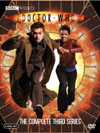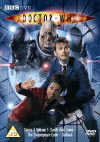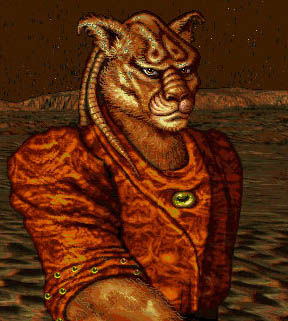DVD Extras (box sets only) include:
The Doctor and Martha are introduced fairly well, and have an excellent scene together in the TARDIS interior. However, the TARDIS itself is not having its greatest day, as all materializations of the police box are neglected for the second story in a row. Not a good idea to be ignoring this so often this early for any viewers who started watching the show when Martha joined, and not very satisfying for the long-term fans either. At least there is some wisdom in the smooth juxtaposition of TARDIS interior and exterior scenes, when a nearby cutaway scene could easily have interrupted them if a certain 1980's mentality had entered the editing room. That cutaway scene, featuring characters from a previous story, is gold within the first half of the story - pretty much the only thing sustaining a bit of anticipation that the tale is headed somewhere interesting. The exploration of the setting continues, and is vastly disappointing. It actually turns out to be New Earth again, an "alien" planet that tries too hard to make us feel like we haven't actually left Earth. And instead of exploring the futuristic side of things, we're stuck in the slums, looking at a run down environment filled with various run-down & desperate people. Just as things feel like they might be picking up a bit via some action, we instead get trapped inside some tiny flying cars in a traffic jam. This drags on throughout the second quarter of the story, without anything in it to suggest that we won't continue to be stuck in those tiny cars for the rest of the entire adventure, and it all begins to feel like a cheap "filler" story within the season. The single biggest improvement this script would have needed would have been to put something more into this section, maybe several somethings, to help the audience anticipate the variety of story elements coming up in the second half. One seriously risks losing the casual viewers at that point, who have become well-accustomed to cost-cutting episode structures on TV, and in sci-fi TV in particular. There is a bit of style-over-substance excellence again when the CGI environment of the motorway tunnel comes into view for the Doctor and the audience. I propose that we only find it excellent because it is a difficult special effect. If such a real place existed and they had simply filmed it, who would get excited about a big, filthy old car tunnel? One wouldn't even be able to appreciate the grand scale of the architecture, with all the exhaust fumes blocking our view. And the production has to take a hit for making all the cars in the tunnel exactly the same boring black box, mainly because it was established in "New Earth" (story no. 172), that this particular city is already more believably populated by air cars of several different varieties and colours. The tunnel is also too big and spacious to make the traffic jam feel like a jam. How much are the cars locked by computer control? What would be the logic of preventing them from freely using the upper half of the tunnel?
However, newer viewers will probably just hear a name for some bizarre creatures and not really get enough of their background to glean why they are such a perfect fit for this story. And by the time they are revealed, there isn't much time left to do much with them. One is, at that point, in a hurry to get out of the car situation and on to dealing with the other points of interest in the story. Might this story have worked better by revealing them in the first ten minutes? Probably. In the teaser - likely too soon, although if you don't reveal them in this particular teaser, it's best if the teaser were an entirely different scene. Revealing them in the trailer the previous week? ...well, no, that's a big mistake, as always. In fact, trailers for next week embedded inextricably into the credits are a huge irritant in my book. I'm tuning in next week anyway, and I'd rather not spoil a single frame of a new story for myself a week ahead of time. Now I have to plug my ears and look away at the end of each episode, not to mention not looking at the pictures on the DVD and its packaging while sticking each disc into the DVD player. But I digress.... This story could easily have become a more rewarding two-parter, just by letting the Macra come into their own as they had in their Patrick Troughton tale, and by having their own hand in creating and maintaining this dystopia as they had in their previous story.
Old Rugged DystopiaA traffic jam makes for a very weird dystopia, yet one that resonates with today's society with surprising ease. Viewers will probably be split on whether or not it makes sense that people would still be accepting enough of the length of time that a motorway journey takes to start out on it in the first place - would they not be more keen to find other ways? At times, their reasoning only seems to make sense on subsequent viewing, and still feels a bit contrived to serve the dystopian idea that the writer wants to set up.But, as Brannigan points out, we viewers shouldn't think that we know the New New Yorkers and their motives so well, just before the city launches into a congregational choir singing of "Old Rugged Cross". While easily appreciable for the beautiful melodic qualities the production manages to give it, the lyrics contain some subtext and deeper meanings. DVD owners, turn on your closed-captions if you need to. This hymn, neatly embedded in the heart of a science-fiction dystopia, successfully paints a picture of Christian beliefs as a dystopia in itself, proclaiming an embrace of and love for ritualistic suffering, while the last line, the final exchange of old ways for something brighter and more appropriate, is phrased as something to be procrastinated indefinitely. How often is this aspect of Christianity not only accepted but celebrated by members of our society? And how often do we repeatedly head into the predictable traffic jams on our main city highways, while neglecting to even seek out and learn alternate routes through lesser known streets? Human nature isn't as far flung from the portrayed habits of New New Yorkers as we detached viewers may wish to think. Driving the point home more clearly, two interesting things happen immediately. The final swell of the music coincides with Martha's car being given access to the fast-lane, and her party rushes off to embrace the dystopia's false promises. Contrasting that as the music abruptly ends with a dischord, the Doctor launches off on his own tangent, not just thinking but acting outside the box, literally. It's as if the hymn has spurred him to realize that the time to exchange the cross for the crown is long overdue, and he wastes no time.
Insane, and a bit magnificent!This is the point at which I realized, on first viewing, that "Gridlock" was going to be an interesting story after all, and Murray Gold steps up with some driving heroic music to help drive that point home. Dystopias everywhere beware: the Doctor is in, and he will be as much of a catalyst for change and the unraveling of dystopian power here as he had been previously in "The Macra Terror" and so many other worthy tales. The second half of the story throws a lot of enjoyable twists and turns at the viewer, some literal, some subtle, and at least half of them are accompanied by stunningly beautiful or richly exciting visuals. The Doctor is kept very busy with several heroic story beats, and has a chance to interact with pretty much every other character and setting in the story, even if all too briefly with some of them. Very well done.
5 Billion Year Secret? Really?After being set-up over a year ago, the Face of Boe finally reveals his big "secret" to the Doctor. Don't get too excited. It's had far more build-up than its fair share.A long term fan like myself never really believed that the Doctor was alone in the first place. It neither makes sense in the multi-dimensional model of "parallel" universes that the show needs to continue to allow unlimited heroic choices to co-exist with time-travel, nor does it make marketing sense for the BBC who will bring back Gallifrey and/or any of its many great Time Lord characters the minute that some writer concocts a story that looks like it could get good mileage out of such usage, or that it seems a lot of money could be made on the character's back. Besides, who believes that the Rani wouldn't be found hanging upside down in a tetrap cave should the TARDIS pilot its way to the correct time-space coordinates, or that the Meddling Monk escaped the frozen wastes of the ice planet just to put himself on the front line in a war against the Daleks? Or that one couldn't find Kan'Po Rinpoche or Professor Chronotis sitting in their studies if one lands in England in the correct spot and the correct year? All "secret" silliness aside, the sequences with the Face of Boe and Hame are very enjoyable. The Doctor gives Hame a hard time frequently in this adventure, yet she is always able to come right back without losing her sense of dignity or grace - a novel achievement by actress Anna Hope who is a joy to watch.
The final departure scene departs interestingly from what you normally expect at the end of a Doctor Who story. Visually, the set is nothing you want to be looking at, but it doesn't matter, because the actors and their dynamics are so superb. I may not believe in Gallifrey's non-existence, but Tennant nails his dialogue and puts so much expression into it, you know that the Doctor believes it, and you feel its loss with him. A worthy moment, and a worthy visual closing shot, neatly wrapping up an unusual but very worthwhile adventure.
International Titles:Deutsch: "Festgefahren"Magyar: "Közlekedési dugó"Français: "L'Embouteillage sans fin"Русский: "Пробка"Italiano: "L'ingorgo"This story has become available on DVD:
Note: The full season sets contain commentaries, behind-the-scenes featurettes, and other extras. The smaller volumes only feature the plain episodes. Comments on this article are welcome. You may contact the author from this page:
|











